Learning to resaw well has been a long journey. With all the resawing I’ve done, I’ve found it’s very easy to end up with something like this: a dished out area in one board and an matching hump on the other board. That kind of result is rather minor on small boards, or with stock where there’s ample room for error. But as board sizes increase, so do the probabilities and the scale of the mishaps. How do these things happen and how can they be avoided? I picked up some useful suggestions at the School of Hard Knocks.
Long ago, I built a couple of wonderful small boats. For one of those boats, I made a frame saw and resawed a LOT of cedar into very long planks. (4/4 live edge white cedar, up to 10.5 inches wide and 16 feet long). Minor mishaps there were no problem because the raw boards had more than enough material to produce two 5/16 inch thick boards. More recently, I’ve resawn cherry and walnut, but on a much smaller scale for desk boxes. Smaller pieces mean less opportunity to go astray.
Now, I’m working on something larger than desk boxes and smaller than boats. My lumber for this project is 8/4 African mahogany that varies from 6 inches wide to 10 inches wide. I bought this lumber from Steve Wall Lumber in Mayodan, NC. They have 20 board foot bundles that are packaged for delivery by FedEx. I bought two bundles and am delighted with what Wall Lumber delivers. Both bundles contained clear lumber, S2S, in generous widths, and easily 20 bd. ft. No end checks, splits, knots or other defects. None! The only one complaining is the FedEx delivery guy who carries the 62 pound packages up our steep driveway. (Takes too much time to get out the hand cart.)
The project calls for boards 1 inch thick and 3/4 inch thick. With careful resawing, I can get one of each out of an 8/4 board. OK, scant 1 inch and scant 3/4 inch That’s plenty sturdy enough for a project that is not super critical about board thickness. Scant thicknesses will work. But, there’s not much margin for error. Which also means, no room for going astray. However, the boards are long, up to 4 feet, giving yet more opportunity to go astray.
OK. What goes wrong? What causes the problems? In a single word: inaccuracy. BTW, I used my kerfing plane to establish a 1/2 inch deep kerf around all edges of these boards. That kerf is a lot better at guiding the saw than is a pencil line.
Problems
Inaccuracy in resawing can come from a lot of things:
- Sawing too long from one position.
- Guiding the saw instead of letting the kerf guide the saw.
- Being too aggressive with the saw — “manhandling.”
- Impatience.
No matter what the cause, here’s what happens. Resawing is always done a little from one side, then a little from the other. Switching back and forth frequently eliminates irregularities before they become bothersome. Imagine the cut becoming off by a mere fraction in one direction or the other. Sawing too long from one side lets the problem grow. Then, when you move to the other side, the saw will take the path of least resistance, through that inaccurate kerf. This results in the saw bowing within the cut, creating a dish on one side of the cut. The longer the sawing goes with a bowed path, the deeper the dish gets. Since you can’t see inside the board, the only external awareness you have about this happening is increased friction. It sneaks up slowly, and if you’re manhandling the saw, or holding it with a death grip, you won’t notice the increased friction until it’s too late.
Once a bowed path gets established inside the board it is almost impossible to correct. So, don’t let it get started.
Frequent direction changes are the most important factor for success. Aligning yourself to the work is equally important. As an aside, unlike the boat lumber that I did with a frame saw, I’m cutting this lumber with a common rip saw. Nicely sharpened, but nothing special. It is lighter than the frame saw and has a broader blade that (one hopes) helps keep it moving straight. No matter which saw, the body and saw both have to line up precisely with the cut line.
Stance: I face the work with my shoulders square to the work piece, so that both arms can move as one. I spread my feet about a shoulder’s width distance apart, but position them in a line with the cut. I’m right handed, and place the left foot forward, with the toe exactly in line with the cut. The right foot is back. Why? So I can use the bigger leg muscles to power the work. Using the legs to rock back and forth is far less tiring than just the arms alone, and leads to better accuracy. In fact, when properly lined up, one could pin their elbows to their side and let the legs do all the work.
BIG problem source: Maintaining this stance from both sides of the cut is essential. Not keeping this stance on both sides of the cut was the biggest cause of my problems for a long time. There’s plenty of room to take this stance from the end of the bench. But walk around to the other side of the board and the bench is in the way. Modifying the stance to accommodate simply didn’t work. So, that meant turning the work piece so I could always work from the end of the bench. Open the vise, turn, close the vise, saw, open the vise, turn, close the vise, saw. Yeah, it was too much trouble to turn the board as often as I should have. Instead of turning, I was spending too much time sawing from one side.
Often, way too much from one side. Very slight wanderings were not being quickly corrected from the other side. They added up… until…
Fix: I solved that problem by adding blocks to offset the work piece from the bench. I started with one 2-by and added a second one later. (They have pegs fitted into holes in the face of the bench so they can easily be added to the vise space.) Bingo!!! That provided enough space to maintain the correct stance from either side of the board. No more need for turning the work piece. It stays in the vise and gets approached equally well from both sides. Now, it’s much easier to change directions frequently, as frequently as 25-30 saw strokes at a time. The only need to open the vise now is to raise the work piece as the cut progresses.
Holding the saw: How to hold the saw is almost as important as stance. The operative word is “loose!” I hold the saw loosely enough that only the webs of my thumbs push forward and the inner parts of my fingers pull back. The saw handle is free to move within my grip. Why? That method provides the least “guidance” to the saw. It let’s those kerfs do their work. Holding the saw too tightly leads one to “manhandling” the saw and diverting it’s path. Holding the saw loosely also makes it easier to feel friction increasing, to know about an oncoming bowed path before it’s too late. Over time, I’ve found a comfortable grip with only 2 fingers of each hand in the handle’s hole. Index fingers and pinkie fingers point toward the blade: same on each side. It is a grip that is very balanced, one that prevents favoring one side over the other and keeps the blade nicely centered in the kerf.
Changing directions: Cutting in “sets” of about 30 strokes from one side and then a set of about 30 from the other side has given me the most accuracy.
Cutting angles: I’ve tried many different approaches. The “cut toward the center from all corners” approach works well for pieces that are almost square. For long pieces, I cut with the saw’s tooth line running at 90° across the board … mostly. The majority of the strokes are straight across the board. But for 10 strokes of each “set,” I drop the handle stroke by stroke until the tooth line is at 45°, then another 10 to 12 at 30°. This deepens the kerf line gradually and accurately.
Keep the cut line high: By keeping the cut line about chest high, the arms are less inclined to do the hard work, and thereby less likely to push the cut astray. Keeping the cut high almost forces using the legs, and when done this way the arms can be kept even and the saw centered on the kerf more easily.
Oil the saw: That’s a small tomato sauce can with a cloth rolled up inside it. It’s soaked with light synthetic oil (3-in-one). A couple of quick swipes on each side of the saw after every few direction changes keeps the saw smoothly gliding along.
Take a break: Sawing too long makes one tired. Tiredness leads to impatience. Impatience leads to manhandling. … and so on. Sawing for the length of an Oscar Peterson album, a Travis Tritt album, or a Beethoven piano concerto is about right. Then, take a break and come back refreshed.
…and what to do when it goes wrong? The easiest answer is to stop as soon as you detect the bowing and go saw from the other end of the board. ~carefully~ You’ll have to saw from the other end at some point anyway. Make it good.
Solutions
- Make sure your heart is healthy enough for resawing.
- Work all the way around the board with a kerfing saw.
- Mount the board in a vise in the manner that enables the same stance from both sides of the cut.
- Develop and maintain the same stance from both sides of the cut.
- Hold the saw loosely enough to allow the kerf to guide the saw, not your arms guiding the saw.
- Switch directions frequently. Work in small “sets:” 10 straight across strokes. followed by 10 strokes of increasing angle (about 45°), then 10 strokes at a more acute angle (about 30°).
- Let the kerfs guide the saw, not your arms.
- Switch directions frequently. (90°, 45°, 30°)
- Let the kerfs guide the saw, not your arms.
- Switch directions frequently.
- Raise the work piece in the vise often enough to keep the cut line about chest high.
- Oil the saw every few changes of direction.
- Take a break BEFORE you get tired, grumpy, or impatient.
- Switch directions frequently.
- For resawing that lasts longer than 4 hours, seek immediate medical advice.
Most of all, relax and enjoy!
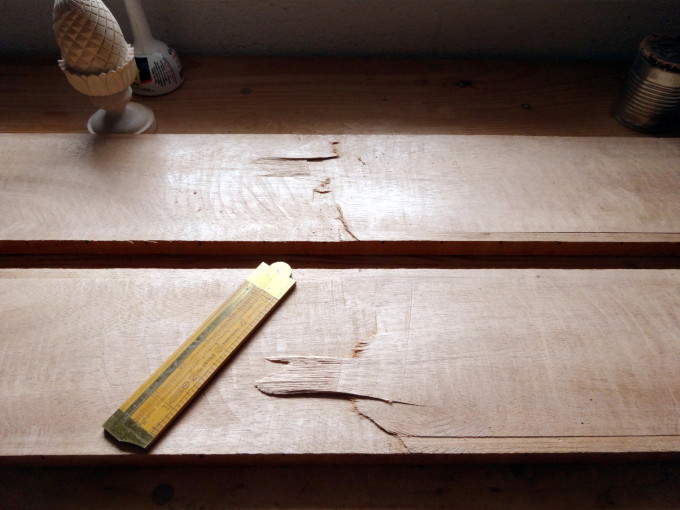
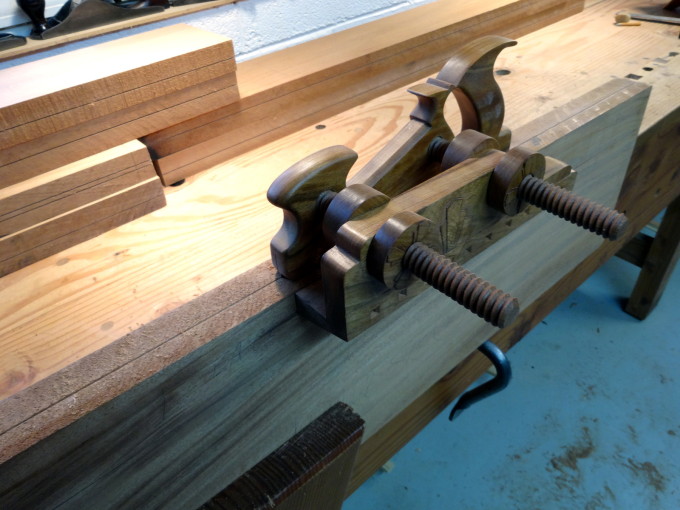
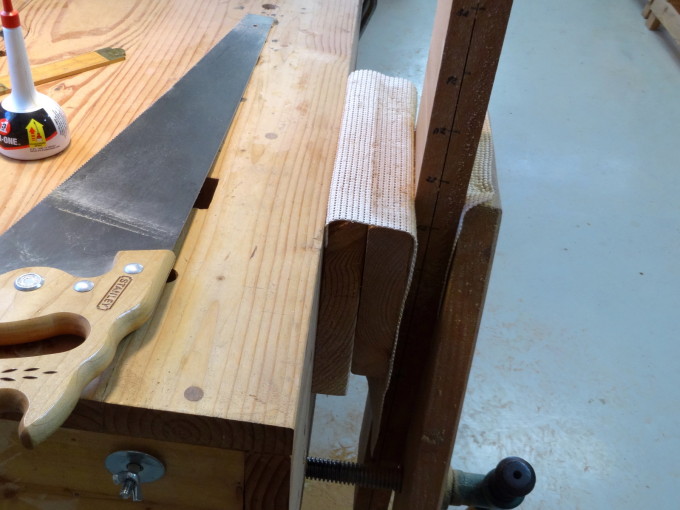
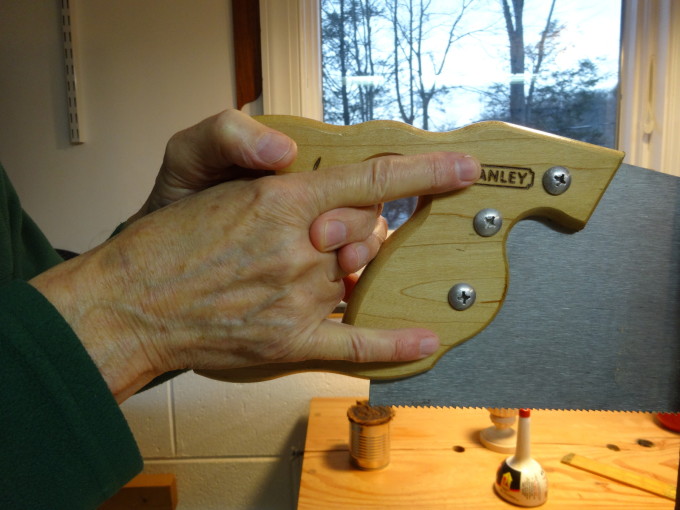
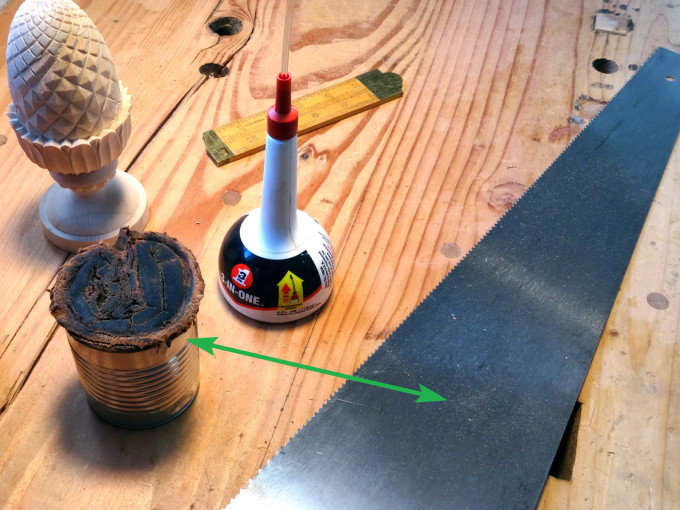
Bob!
This weekend I had to cut the lid of a box. I was affraid of messing the box. The finest saw was smaller then the with of the box…
So I got the same 13 conclusions. It took me 1,5h so I didn’t experienced the 14th!
Great advice!(about seeking medical advice) LOL
I also have one idea for a project. I have the wood (5 3/4″x 1 1/2″x 80″terrible to saw, I belive is bowdichia nitida spruce – discovered it on my father-in-law attic). I’ve been gathering intel about frame saws, You just “gave me” an alternative to Tom Fidgen design! So thanks, 🙂
Great post!
PS, My wife thinks I’m crazy, and I shuld get a bandsaw!
Hi António,
Your wife is right! 🙂
Bob I enjoyed the instructions. I became a member of Tom Fidgen on line classes. He does a lot of resaw with his frame saw. I think Bad Ax carries the parts.He has sold me on how well his frame saw follows the kerf. BOYCE
Great write up, I’m on the fence about selling off most of my power tools and no longer be a “hybrid” woodworker. Not sure which side I’ll teeter off to though. Thanks for all of your food for thought, the follow-up comments remind me that making a bow saw is on my list of things to do — John
awesome, in-depth, and insightful piece.
also — i applaud and admire your eclectic taste in music
Great write up Bob! I now have an information sheet and checklist for when the time comes that I need to do a lot of resawing.
1. purchase a bandsaaw.
LOL
Greg
Goodstuff, here’s my own recent experience with my biggest re-sawing experience with a Japanese saw: http://lumberjocks.com/siavosh/blog/53154
Boyce,
The Bad Ax blade looks like a good deal. It’s a lot easier than cutting one out of an old saw.
Thanks John. Now, is that a ¨bow saw¨as in a good heavy frame saw or as in a turning saw? If the latter, I think the Tools For Working Wood bow saw is excellent. I built one from their plans several years ago and love it.
Thanks John Sayles. Here’s another music selection for you. This one is my favorite Nino Bravo song: https://www.youtube.com/watch?v=w14wP1wWU0o (love the disco era costume!)
Thanks Greg, if that bandsaw will resaw 11 inch widths, I’ll be right over.
Hi Siavosh, the cieling in my shop is too low for the Japanese medhod. 🙂 Nice work!
Great list of advice, Bob!
Hand sawing is a learning experience, but resawing by hand feels like it will take a lifetime to master. Not as easy as it looks. My resaws look like a rat chewed it out, as one Englishman is fond of saying. Oh well, one day.
Yes, yes, and yes! Well written Bob. In my experience resawing is not an exhausting experience if you do it right. It is indeed all in the legs. Granted I’m using a dedicated frame saw with 3 ppi and its aggressive geometry and weight do all the work. But the minute you “try” to push it, it will get difficult. Most of the time my arms are locked in place and I’m just stepping forward and back and letting the teeth glide over the wood. This is akin to free hand sharpening where you try to minimize the hinge points and it will really help your accuracy. My biggest epiphany was with working with my 48″ saw and realizing that with such a long stroke, the slightest misalignment of my body would translate to a wildly errant cut on the back side of the board. Now if you watch me resaw you will see a very relaxed posture but a hyper vigilant look of concentration on my face as I focus on maintaining my line through the wood with micro adjustments on every stroke. But I can’t think of a time where I have become short of breath (and I’m not athlete!) because it is the relaxed stroke that keeps the saw in line.
Derek,
You CAN tame that rat! Until then, leave room for trimming. 🙂
Shannon,
You got it! I’ve been thinking of re-toothing my frame saw from its current 5 ppi to 3. Maybe for the next batch of resawing. Almost done with this round.
Great article, right up our alley as we have a boatload of eastern red cedar from, you guessed it, Wall Lumber, that we have been resawing. We have had exactly the same issues as you, and look forward to trying your techniques to get better results.
Hey Paul,
Good luck with the cedar. It might go a little faster than the mahogany. 🙂
As mentioned in the article, I’ve been using a plain rip saw, thinking that lighter weight might mean less work. I just switched to the frame saw I made long ago, after Shannon’s mention of letting the heavier saw do the work. It goes a lot faster.
If you have a heavy frame saw, use it.
So, is that boatload of cedar intended for boats?
That red cedar would make a beautiful boat, but no, we’re not quite ready for boatbuilding yet. We live close to Wall Lumber and were able to take advantage of a special they ran a while back, I think it was 100 board feet of 4/4 eastern red cedar for $150. We have resawed some of it to make boxes and are gradually getting better at it. We have a bow saw that we made in the shop, but the blade is more suited for cutting firewood and we haven’t had any luck resawing with it. After reading your post about using a frame saw, I might re-blade our bow saw with something not quite as radical and have a go.
I know you are a sailor, Bob, and if you ever want to browse a site about sailing on the Neuse River and Pamlico Sound of North Carolina, I invite you to check out my other website, http://www.neuseriversailors.com. Couple of good articles there about the Georgetown Wooden Boat Show.
Paul and I made a kerfing saw to make our kerfs out of an old saw blade which is the same thickness as the saws that we resaw with. It, in itself was a fun project (aside from the fact that hickory is a very hard wood) and we have used it often. We enjoy making our own tools and jigs. For just stating out, I think we’ve made great progress and projects. Visit our website- http://www.woodshop.neuseriversailors.com
Joe and Paul,
Lots of nice work going on at your shop!
Thanks for the boating link.
Hello Bob,
great post. Thanks for sharing this experiences.
I’m just in the situation of doing some resawing in the very near future.
I think I will try out some of your advices. It is pretty well explained and makes sense to me.
For the time being I only have got a 4,5 ppi and a 8 ppi plain rip saw.
Which one would you prefer? The 4,5?
Cheers,
Stefan
Hello Stefan,
Of those two saws, I would definitely use the 4.5.
That’s a fine looking first aid cabinet. It has a crisp design aesthetic and is very nicely made. Pleasing to look at!
Keep making more.
Hey Bob,
thanks for your kind words regarding my first aid cabinet.
I want to let you know, just grabbed my 4.5 ppi rip saw today and made some cuts following your advices.
And what can I say? All of the sudden it goes a lot easier.
You know what? I think I’ll build a frame saw. I’ve got a 600mm 5ppi blade laying around, and enough beech cut offs.
I think I will report about it within the next weeks.
Cheers,
Stefan
Good to hear Stefan! You’ve gained another skill.
Thanks for writing out that resaw checklist – I always overlook ‘oiling the saw’. I generally put wax on my saws at the end of the day to protect from rust, but maybe adding some before I start work with them would be beneficial, too.
Hi Fil,
Depending on how the wood behaves, oiling or waxing more often can be very helpful. Sometime a piece of wood releases it’s tension when sawing, causing the cut to try to close up, causing more friction on the saw. That’s when the oiling really helps.
It may also help to insert thin wedges into the kerf to keep the wood from closing up as internal stresses are relieved.